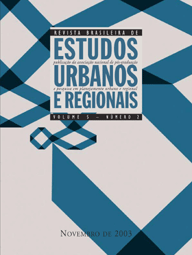Do Pruitt-Igoe ao World Trade Center: planejando a ex/implosão do (pós)modernismo
DOI:
https://doi.org/10.22296/2317-1529.2003v5n2p9Palabras clave:
arquitetura moderna, pós-modernidade, Pruitt-Igoe, World Trade Center.Resumen
O artigo discute, em meio a conceitos de pós-modernidade, as semelhanças na destruição de dois marcos da arquitetura moderna: o conjunto residencial Pruitt-Igoe (PI) e o World Trade Center (WTC). Argumenta que a destruição, tanto do PI como do WTC, deveu-se não apenas à questão física (no PI, uma destruição planejada pela sociedade, e no WTC, uma destruição por ela não planejada); pelo contrário, a queda de ambos os edifícios seria uma materialização do fim do pensamento modernista, do qual seriam símbolos. Contrariamente ao que foi dito a respeito do 11/09/2001, propõe que naquela hora o mundo já havia mudado e que a destruição do WTC foi apenas a representação da mudança. Seguindo essa argumentação, o artigo propõe inovações no campo do planejamento e da arquitetura, assim como novas concepções para espaços contemporâneos, a exemplo dos projetos do novo WTC.
Descargas
Citas
ANGOTTI, T. “Planning to rebuild: the issues ahead.” Planners Network, n.149(1), p.16-7, 2001.
ANNAN, K. “From Doha to Johannesburg by way of Monterrey: how to achieve, and sustain, development in the 21st century.” Palestra proferida na London School of Economics and Political Science. Londres, 25/2/2002.
ARCHITECTURAL RECORD. The Max Protetch Gallery Exhibit. “A New World Trade Center: Design Proposals”, mar. 2002.
BAUDRILLARD, J. The mirror of production. Saint Lois: Telos Press, 1975.
CASTELLS, M. “The world has changed: can planning change?” In: ACSP ANNUAL MEETING. 1990. Proceedings… Austin, Texas, 2/11/1990.
CRYPTOME. “Interesting comments on WTC Architecture and History.” Acesso em 2001 http://cryptome.org/wtc-collapse.htm
DALLMAYR, F. “Lessons of September 11.” Theory, Culture & Society: Explorations in Critical Social Science, v.19, issue 04, ago. 2002.
GAUSE, D. G.; LAWRENCE, B. “User-Driven Design: incorporating users into the requirements and design phase.” Acesso em: http://www.stickyminds.com/sitewide.asp?ObjectId=2659&Function=DETAILBROWSE&ObjectType=ART (Originamelmente publicado na revista STQE, jan./fev. 1999.)
GLANCEY, J. “Reaching for the sky: on the passion for tall buildings and what Tuesday’s events could mean for the future shape of our cities.” The Guardian, 15/9/2001. Acesso em http://www.guardian.co.uk/saturday_review/story/0,3605,552020,00.html
HARVEY, D. The condition of postmodernity. Oxford: Blackwell, 1989.
IRAZÁBAL, C. “Architecture and the production of postcard images: invocations of tradition vs. critical transnationalism in Curitiba.” In: ALSAYYAD, N. (Ed.). The end of tradition. Londres: Routledge, 2003.
JACOBS, J. M. “The global domestic: the highrise postcolonially considered.” CED – Architecture Lecture Series, University of California, Berkeley, 2000. (1 Videocassete, 76 min., VHS.)
JENCKS, C. El lenguaje de la arquitectura postmoderna. Barcelona: Editorial Gustavo Gili, 1981.
JENCKS, C. Late-Modern Architecture. Nova York: Rizzoli International Publications, 1980.
JENKS, H. “September 11. One year later: Mary Dudziak reflects on the transformative nature of 9/1/01.” El Boletín, Center for American Studies & Ethnicity and the Program in American Studies & Ethnicity, University of Southern California, 6, 2002.
LARA, F. “Depois do World Trade Center?” Vitruvius, 2001. Acesso em: www.vitruvius.com.br
LEY, D. “Postmodernity”. In: JOHNSTON, R.J. (Ed.). The Dictionary of Human Geography. 4.ed. Malden, MA: Blackwell Publishers, 2000. p.622-3.
LYNCH, K. “City and regional planning.” In: BANERJEE, T.; SOUTHWORTH, M. (Eds.). City sense and city design. Cambridge, MA: The MIT Press, 1973.
MACDONALD, D. Democratic Architecture: practical solutions to today’s housing crisis. Nova York: Whitney Library of Design/Watson-Guptill Publications, 1996.
MARCUSE, P. “Planning after September 11: the issues in New York.” Planners Network, n.150, p.36-9, 2002.
MARCUSE, P. “Urban life will change: proposals for rebuilding.” Planners Network, n.149(1), p.15-6, set./dez. 2001.
MUSCHAMP, H. “New Trade Center idea: move bulk to West St.” New York Times, 25/7/2002.
NEWMAN, O. Defensible space; crime prevention through urban design. Nova York: Macmillan, 1972.
SASSEN, S. “Governance hotspots: challenges we must confront in the post-September 11 World.” Theory, Culture & Society: Explorations in Critical Social Science, v.19, issue 04, ago. 2002.
SASSEN, S.; DORFMAN, A.; CHOMSKY, N.; EL SARRAJ, E.; RABIN, Y.; PLATKIN, D.; MOORE, M.; GALEANO, E. “The Seventh Generation.” Planners Network, n.149(1), p.18-20, 2001.
SCHOOL OF JOURNALISM AND THE CONGRESS FOR THE NEW URBANISM. “Rebuilding Lower Manhattan: A discussion.” The Terner Series on Urban Development, University of California at Berkeley, 26/9/2001.
SEGRE, R. “World Trade Center (1973-2001): fragilidade de um ícone urbano.” Vitruvius. Acesso em 2001 www.vitruvius.com.br
SIM, S. (Ed.). The Routledge Critical Dictionary of Postmodern Thought. Nova York: Routledge, 1999.
SPEAKS, M. “It’s out there: the formal limits of the American avant-garde.” Architectural Design, Londres, 68(5/6): 26-31, maio/jun. 1998.
WIKIPEDIA. “Minoru Yamasaki.” Acesso em 2001 http://www.wikipedia.com/wiki/Minoru_Yamasaki
WIKIPEDIA.“World Trade Center.” Acesso em 2001 http://www.wikipedia.com/wiki/World_Trade_Center
WISOTZKI, R. “Rafael Courtoisie busca una gran revelación en una página. A las torres de palabras no las derriba un avión.” El Nacional, Caracas, 24/11/2001.
Descargas
Publicado
Cómo citar
Número
Sección
Licencia
Derechos de autor 2017 Revista Brasileira de Estudos Urbanos e Regionais

Esta obra está bajo una licencia internacional Creative Commons Atribución 4.0.
Los autores que publican en esta revista aceptan los siguientes términos:
1) Los autores que publican en la RBEUR conservan los derechos sobre su obra y otorgan a la revista el derecho de primera publicación, realizada bajo la Licencia Creative Commons Attribution que permite compartir la obra y asegura el reconocimiento de la autoría y del vehículo de publicación original, la RBEUR.
2) Los autores son libres para publicar y distribuir de forma no exclusiva la versión del trabajo publicado en esta revista (por ejemplo, publicar en repositorio institucional o como capítulo de un libro), reafirmando la autoría y el reconocimiento del vehículo de publicación original, la RBEUR.












.png)
